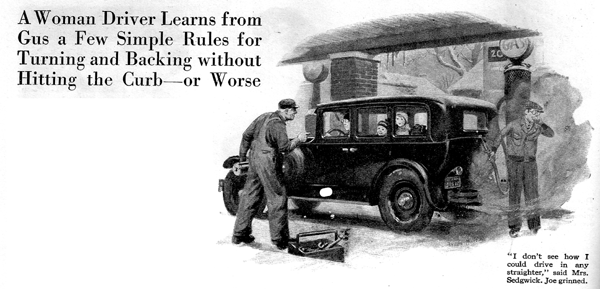January 1930
STEERING THE CAR OUT OF TROUBLE
by Martin Bunn

"Watch out," Joe Clark called warningly to his partner, Gus Wilson. "Here comes Mrs. Sedgwick trundling her combination rolling nursery and dog kennel."
Gus looked up from his work just in time to see Mrs. Sedgwick cut in to the Model Garage gasoline pump so closely that the rear wheel bounced over the curbing.
"There," she said pointedly, "I hit that curb again. "Too bad, Mr. Wilson, that you didn't make your driveway wide enough so that a car can get into it without bumping into something."
Joe repressed a snicker as he started the gasoline flowing, for the driveway was plenty wide and the curved approach was not especially severe.
"I guess it ought to be a little wider," agreed Gus placatingly, "but if you'd cut over a little further when you drive in I am sure you wouldn't have any trouble."
Whatever reply Mrs. Sedgwick may have made was drowned by the clamor of the children, accompanied by the yapping of the dog.
"Dear me," complained Mrs. Sedgwick distractedly, "every time I stop, the children insist on getting ice cream cones. As I was saying, "she went on, "I don't see how I could drive into this place any straighter. I know the front wheels were exactly in the middle of the road."
"That's just what's the matter," observed Gus with a smile. "Joe," he said, "why don't you take the kids down and get them some ice cream cones. Meanwhile, I'll show Mrs. Sedgwick some tricks in handling a car."
Mrs. Sedgwick nodded agreement and Joe started down the road with a youngster dangling on each arm and the dog hopping about underfoot.
"Well," observed Gus, "one thing that lots of drivers never seem to get the hang of is maneuvering a car in close quarters. That's your trouble, Mrs. Sedgwick. There's nothing hard about it -- if you'll once get straightened out on just what goes on when you turn the steering wheel. The car really doesn't turn. It's dragged around when you're going forward, or pushed around when you're going backward. When you turn the steering wheel the front wheels, instead of rolling straight ahead, start rolling off at an angle and they pull the front of the car along with them. The rear wheels actually resist this motion. They are being pulled out of the line that they naturally would roll in.
"The next thing to get settled is the fact that the front wheels and the rear wheels never roll in exactly the same track except when the front wheels are pointed straight ahead. The minute you turn the front wheels in either direction the car makes four tracks on the ground, two for the front wheels and two for the rear wheels. The third point is that whenever you go around a curve the tracks of the rear wheels always are nearer the curb than the tracks of the front wheels. That's why the back of the car may hit something even after the front clears it."
"It's funny," exclaimed Mrs. Sedgwick, "that nobody ever bothered to tell me that before. Now I can see why I keep hitting curbstones with the rear wheels when I go round corners real sharp. Just for fun, I think I'll drive out and then drive in again and see if I can do it without hitting the curbstone this time."
"That's the idea," said Gus; "and when you come in this time steer the front wheels over a ways toward the outside edge of the drive. Then there'll be room for the rear wheels to cut inside there and still clear the curbstone."
Gus watched while Mrs. Sedgwick drove around again. This time she cleared the curb by at least a foot.
"You've got the idea now," said Gus. "The next thing is to back up right. In backing, you figure things out exactly the reverse of driving forward. The front wheels, not at the rear, always go outside the curve of the rear wheels. Backing into a curved driveway isn't hard if you remember to steer so that the rear wheels hug the inside edge of the driveway. Then there will be plenty of room for the front wheels to swing outside them without hitting the other side of the driveway. Suppose you go out on the road now and try and back in front of the gasoline pump. Take it slow." Mrs. Sedgwick tried it with only fair success. She cut in so close that the rear wheel jammed against the curb.
"It's so confusing," she said, "to try to remember which way to turn the wheel when you are steering backward. I always turn it the wrong way."
"That's natural," explained Gus, "The trouble is when you are going backward the steering wheel seems to work the wrong way. Try to forget there's a steering wheel, and while you are looking out the window backwards place your forearm across the wheel with your right hand grasping the left edge of it. Then remember to pull your hand toward you when you want the car to turn toward the side on which you are looking, or push your hand away from you if you want the car to turn the opposite way."
Mrs. Sedgwick tried it again, and managed much better.
"I certainly am grateful to you, Mr. Wilson." She smiled enthusiastically. "Is there anything else I ought to know?"
"Just one thing," said Gus, "and that is take your time. If you get confused, throw the gear lever into neutral, put on the brake and figure out what to do."
END
L. Osbone 2019